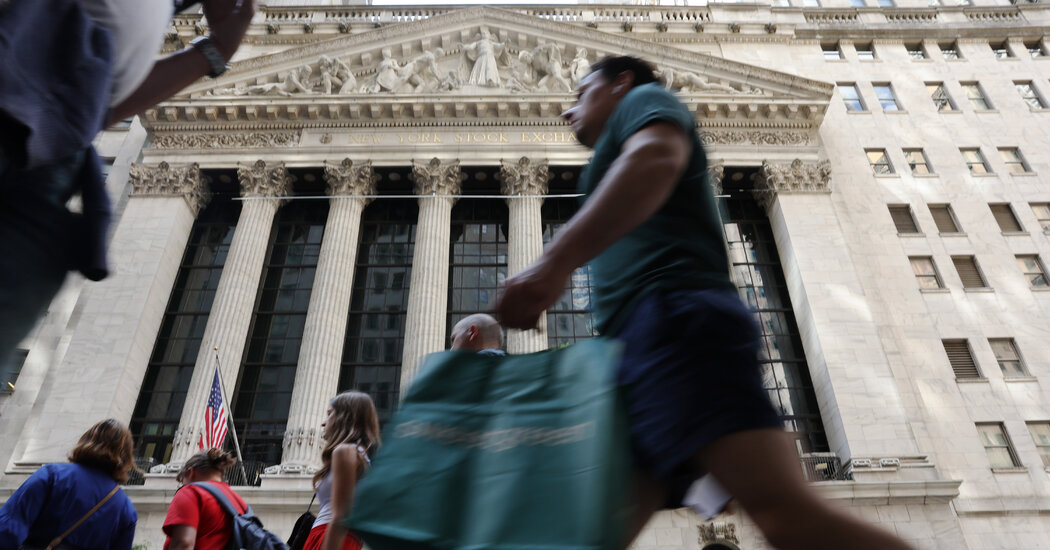What Higher Interest Rates Mean for Mortgages, Credit Cards and More
The Federal Reserve is expected to raise interest rates on Wednesday, the latest in a series of increases that have squeezed the budgets of debt-laden Americans, while rewarding those with money to stash in savings.
The Federal Reserve has already raised its benchmark rate, the federal funds rate, to a range of 5 to 5.25 percent to rein in inflation, which is showing signs of slowing. But prices remain elevated, leading the Fed to keep rates high for a prolonged period of time.
That means the cost of credit cards and mortgages may remain relatively high, making it more difficult for people who want to pay down debt — as well as those who want to take out new loans to renovate their kitchen or buy a new car.
“We were very spoiled for a while with low rates, and that lulled us into a false sense of security in terms of what the true cost of debt can be,” said Anna N’Jie-Konte, president of Re-Envision Wealth, a wealth management firm.
Here’s how different rates are affected by the Fed’s decisions — and where they stand now.
Credit cards
Credit card rates are closely linked to the Fed’s actions, which means consumers with revolving debt have seen those rates rise over the past year — and quickly (increases usually occur within one or two billing cycles).
The average credit card rate was 20.44 percent as of July 19, according to Bankrate.com, up from around 16 percent in March last year, when the Fed began its series of rate increases.
People carrying credit card debt should focus on paying it down and assume rates will continue to rise. Zero-percent balance transfer offers can help when used carefully (they still exist for people with good credit, but come with fees), or you might try negotiating a lower rate with your card issuer, said Matt Schulz, chief credit analyst at LendingTree. His research found that such a tactic often works.
Car loans
Higher loan rates have been dampening auto sales, particularly in the used-car market, because loans are more expensive and prices remain high, experts said. Qualifying for car loans has also become more challenging than it was a year ago.
“The vehicle market has challenges with affordability,” said Jonathan Smoke, chief economist at Cox Automotive, a market research firm.
The average rate on new car loans in June was 7.2 percent, up slightly from the start of the year, according to Edmunds.com. Used-car rates were even higher: The average loan carried a 11 percent rate in June, down from a recent high of 11.4 percent in March.
Car loans tend to track the five-year Treasury note, which is influenced by the Fed’s key rate — but that’s not the only factor that determines how much you’ll pay. A borrower’s credit history, the type of vehicle, loan term and down payment are all baked into that rate calculation.
Mortgages
Rates on 30-year fixed-rate mortgages don’t move in tandem with the Fed’s benchmark rate, but instead generally track the yield on 10-year Treasury bonds, which are influenced by a variety of factors, including expectations around inflation, the Fed’s actions and how investors react to all of it.
Mortgage rates have been volatile. After climbing above 7 percent in late October — for the first time since 2002 — mortgage rates dipped close to 6 percent in February before drifting back up again to 6.78 percent as of July 20, according to Freddie Mac. The average rate for an identical loan was 5 percent the same week in 2022.
Other home loans are more closely tethered to the Fed’s moves. Home-equity lines of credit and adjustable-rate mortgages — which each carry variable interest rates — generally rise within two billing cycles after a change in the Fed’s rates. The average rate on a home-equity loan was 8.47 percent as of July 19, according to Bankrate.com, up from 5 percent a year ago.
Student Loans
Borrowers who already hold federal student loans are not affected by the Fed’s actions because that debt carries a fixed rate set by the government. (Payments on most of these loans have been paused for the past three years as part of a pandemic relief measure, and are set to become due again in October.)
But new batches of federal student loans are priced each July, based on the 10-year Treasury bond auction in May. And those loan rates have climbed: Borrowers with federal undergraduate loans disbursed after July 1 (and before July 1, 2024) will pay 5.5 percent, up from 4.99 percent for loans disbursed in the year-earlier period. Just three years ago, rates were below 3 percent.
Graduate students taking out federal loans will also pay about half a point more, or about 7.05 percent on average, as will parents, at 8.05 percent on average.
Borrowers of private student loans have already seen those rates climb thanks to the prior increases. Both fixed- and variable-rate loans are linked to benchmarks that track the federal funds rate.
Savings Vehicles
Savers seeking a better return on their money have had an easier time: Rates on online savings accounts, along with one-year certificates of deposit, have reached their highest levels in more than a decade. But the pace of those increases is slowing.
“Consumers now have several options to earn over 5 percent yield on their cash,” said Ken Tumin, founder of DepositAccounts.com, part of LendingTree.
An increase in the Fed’s key rate often means banks will pay more interest on their deposits, though it does not always happen right away. They tend to raise their rates when they want to bring more money in.
The average yield on an online savings account was 4.08 percent as of July 1, according to DepositAccounts.com, up from 1.04 percent a year ago. But yields on money market funds offered by brokerage firms are even more alluring because they have tracked the federal funds rate more closely. The yield on the Crane 100 Money Fund Index, which tracks the largest money market funds, was recently 4.96 percent.
Rates on certificates of deposit, which tend to track similarly dated Treasury securities, have also been ticking higher. The average one-year C.D. at online banks was 4.89 percent as of July 1, up from 1.75 percent a year earlier, according to DepositAccounts.com.


